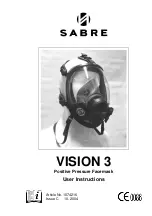
7
Since the Back-to-Back Calibration technique relies on
each sensor experiencing an identical acceleration level,
proper mounting of the test sensor to the reference
standard is imperative. Sensors with mounting holes are
attached directly to the reference standard with a stud
tightened to the recommended mounting torque. A
shouldered mounting stud is typically used to prevent the
stud from “bottoming out” in the hole. Both mounting
surfaces are precision-machined and lapped to provide a
smooth, flat interface according to the manufacturer’s
specification. A thin layer of silicone grease is placed
between the mating surfaces to fill any imperfections and
increase the mounting stiffness. The cables are stress-
relieved by first routing them to the shaker head, then to a
nearby stationary location. This reduces cable motion and
helps to prevent extraneous motion or stresses from being
imparted into the system. A typical set-up is shown in
Figure 12.
Figure 12.
Typical Calibration Set-Up
Adhesively mounted sensors use similar practices.
However, in this case, a small portion of quick-bonding
gel, or similar temporary adhesive, is used to attach the
test sensor to a reference standard designed with a smooth,
flat mounting surface.
In addition to mounting, the selection of the proper
equipment is critical. Some of the more important
considerations include: 1) the reference standard must be
specified and previously calibrated over the frequency
and/or amplitude range of interest; 2) the shaker should be
selected to provide minimal transverse (lateral) motion
and minimal distortion; and 3) the quality of the meters,
signal generator, and other devices should be selected so
as to operate within the limits of permissible error.
8.4 COMMON MISTAKES
Most calibration errors are caused by simply overlooking
some of the fundamental principals of dynamics. This section
attempts to address some of the more common concerns.
For stud-mount sensors, always mount the accelerometer
directly to the reference standard. Ensure that the mounting
surfaces are smooth, flat, and free of any burrs. Always use a
coupling fluid, such as silicone grease, in the mounting
interface to maintain a high mounting stiffness. Mount the
sensor according to the manufacturer’s recommended
mounting torque.
Figure 13.
Stud Mounting
For adhesive mount sensors, use a thin, stiff layer of
temporary adhesive such as quick-bonding gel or superglue.
DO NOT use excessive amounts of glue or epoxy, as the
mounting stiffness may be reduced and compromise high-
frequency performance. It may also damage the sensor
during removal.
Figure 14
.
Incorrect Adhesive Mounting
Triaxial accelerometers should always be mounted
directly to the reference standard. Use of adaptors may be
required for calibration of three individual accelerometers
oriented in a triaxial arrangement. The vibration at the test
sensor’s sensing element may differ from the vibration at
the reference standard due to a “cantilever” effect, seen in
Figure 15.
Figure 15.
Mounting Triaxial Sensors (Incorrect)


































